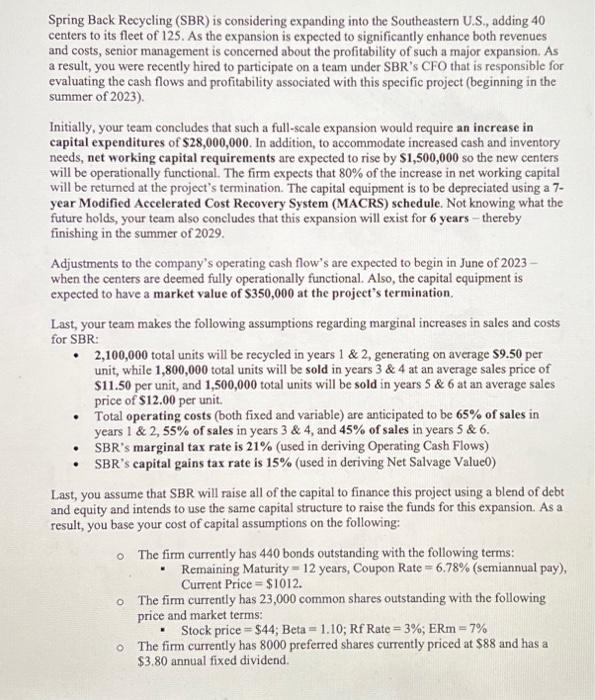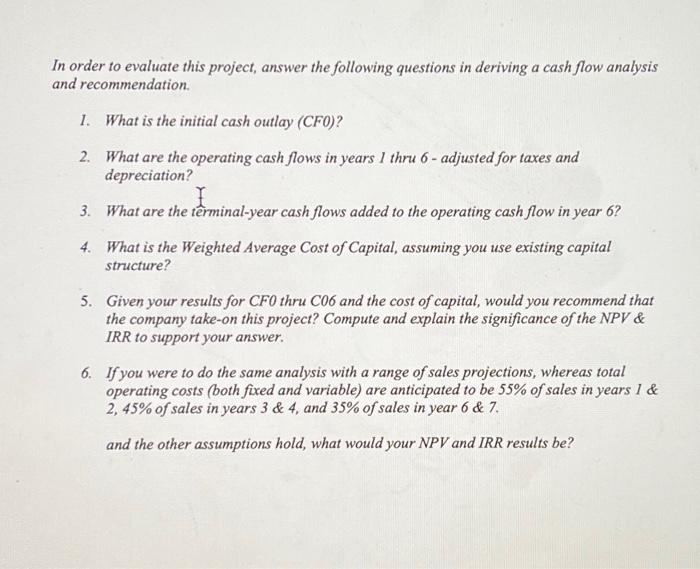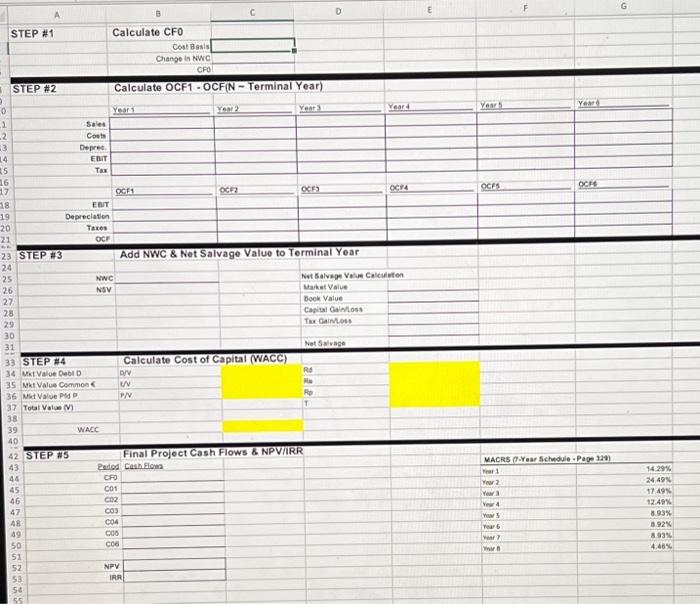Spring Back Recycling (SBR) is considering expanding into the Southeastern U.S., adding 40 centers to its fleet of 125. As the expansion is expected to significantly enhance both revenues and costs, senior management is concerned about the profitability of such a major expansion. As a result, you were recently hired to participate on a team under SBR's CFO that is responsible for evaluating the cash flows and profitability associated with this specific project (beginning in the summer of 2023). Initially, your team concludes that such a full-scale expansion would require an increase in capital expenditures of $28,000,000. In addition, to accommodate increased cash and inventory needs, net working capital requirements are expected to rise by $1,500,000 so the new centers will be operationally functional. The firm expects that 80% of the increase in net working capital will be retumed at the project's termination. The capital equipment is to be depreciated using a 7year Modified Accelerated Cost Recovery System (MACRS) schedule. Not knowing what the future holds, your team also concludes that this expansion will exist for 6 years - thereby finishing in the summer of 2029. Adjustments to the company's operating cash flow's are expected to begin in June of 2023 when the centers are deemed fully operationally functional. Also, the capital equipment is expected to have a market value of $350,000 at the project's termination. Last, your team makes the following assumptions regarding marginal increases in sales and costs for SBR: - 2,100,000 total units will be recycled in years 1 \& 2, generating on average $9.50 per unit, while 1,800,000 total units will be sold in years 3&4 at an average sales price of \$11.50 per unit, and 1,500,000 total units will be sold in years 5&6 at an average sales price of $12.00 per unit. - Total operating costs (both fixed and variable) are anticipated to be 65% of sales in years 1&2,55% of sales in years 3 \& 4 , and 45% of sales in years 5&6. - SBR's marginal tax rate is 21% (used in deriving Operating Cash Flows) - SBR's capital gains tax rate is 15% (used in deriving Net Salvage Value0) Last, you assume that SBR will raise all of the capital to finance this project using a blend of debt and equity and intends to use the same capital structure to raise the funds for this expansion. As a result, you base your cost of capital assumptions on the following: The firm currently has 440 bonds outstanding with the following terms: - Remaining Maturity = 12 years, Coupon Rate =6.78% (semiannual pay), Current Price =$1012 The firm currently has 23,000 common shares outstanding with the following price and market terms: - Stock price =$44; Beta =1.10;Rf Rate =3%;ERm=7% The firm currently has 8000 preferred shares currently priced at $88 and has a $3.80 annual fixed dividend. In order to evaluate this project, answer the following questions in deriving a cash flow analysis and recommendation. 1. What is the initial cash outlay (CF0)? 2. What are the operating cash flows in years 1 thru 6 -adjusted for taxes and depreciation? 3. What are the terminal-year cash flows added to the operating cash flow in year 6 ? 4. What is the Weighted Average Cost of Capital, assuming you use existing capital structure? 5. Given your results for CF0 thru CO6 and the cost of capital, would you recommend that the company take-on this project? Compute and explain the significance of the NPV \& IRR to support your answer. 6. If you were to do the same analysis with a range of sales projections, whereas total operating costs (both fixed and variable) are anticipated to be 55% of sales in years 1 \& 2,45% of sales in years 3&4, and 35% of sales in year 6&7. and the other assumptions hold, what would your NPV and IRR results be? Spring Back Recycling (SBR) is considering expanding into the Southeastern U.S., adding 40 centers to its fleet of 125. As the expansion is expected to significantly enhance both revenues and costs, senior management is concerned about the profitability of such a major expansion. As a result, you were recently hired to participate on a team under SBR's CFO that is responsible for evaluating the cash flows and profitability associated with this specific project (beginning in the summer of 2023). Initially, your team concludes that such a full-scale expansion would require an increase in capital expenditures of $28,000,000. In addition, to accommodate increased cash and inventory needs, net working capital requirements are expected to rise by $1,500,000 so the new centers will be operationally functional. The firm expects that 80% of the increase in net working capital will be retumed at the project's termination. The capital equipment is to be depreciated using a 7year Modified Accelerated Cost Recovery System (MACRS) schedule. Not knowing what the future holds, your team also concludes that this expansion will exist for 6 years - thereby finishing in the summer of 2029. Adjustments to the company's operating cash flow's are expected to begin in June of 2023 when the centers are deemed fully operationally functional. Also, the capital equipment is expected to have a market value of $350,000 at the project's termination. Last, your team makes the following assumptions regarding marginal increases in sales and costs for SBR: - 2,100,000 total units will be recycled in years 1 \& 2, generating on average $9.50 per unit, while 1,800,000 total units will be sold in years 3&4 at an average sales price of \$11.50 per unit, and 1,500,000 total units will be sold in years 5&6 at an average sales price of $12.00 per unit. - Total operating costs (both fixed and variable) are anticipated to be 65% of sales in years 1&2,55% of sales in years 3 \& 4 , and 45% of sales in years 5&6. - SBR's marginal tax rate is 21% (used in deriving Operating Cash Flows) - SBR's capital gains tax rate is 15% (used in deriving Net Salvage Value0) Last, you assume that SBR will raise all of the capital to finance this project using a blend of debt and equity and intends to use the same capital structure to raise the funds for this expansion. As a result, you base your cost of capital assumptions on the following: The firm currently has 440 bonds outstanding with the following terms: - Remaining Maturity = 12 years, Coupon Rate =6.78% (semiannual pay), Current Price =$1012 The firm currently has 23,000 common shares outstanding with the following price and market terms: - Stock price =$44; Beta =1.10;Rf Rate =3%;ERm=7% The firm currently has 8000 preferred shares currently priced at $88 and has a $3.80 annual fixed dividend. In order to evaluate this project, answer the following questions in deriving a cash flow analysis and recommendation. 1. What is the initial cash outlay (CF0)? 2. What are the operating cash flows in years 1 thru 6 -adjusted for taxes and depreciation? 3. What are the terminal-year cash flows added to the operating cash flow in year 6 ? 4. What is the Weighted Average Cost of Capital, assuming you use existing capital structure? 5. Given your results for CF0 thru CO6 and the cost of capital, would you recommend that the company take-on this project? Compute and explain the significance of the NPV \& IRR to support your answer. 6. If you were to do the same analysis with a range of sales projections, whereas total operating costs (both fixed and variable) are anticipated to be 55% of sales in years 1 \& 2,45% of sales in years 3&4, and 35% of sales in year 6&7. and the other assumptions hold, what would your NPV and IRR results be











